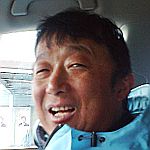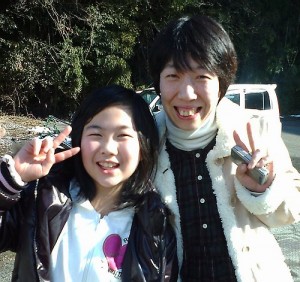
Nanami (9) and mother, Mrs. Kondo
January 29, 2009 Today I went to the city of Kashiwazaki to see my friends Nobuo and Miwako. Kashiwazaki is home to the largest nuclear powerplant in the world — built right smack dab on an earthquake fault! The area was hit by a magnitude 6.8 earthquake on July 16, 2007. The nuclear reactors immediately shut down and continue to remain down at the time of this post. It may be several more months before the inspectors are sure the reactors are safe enough to turn back on.
I left home around 9:15AM and walked 20 minutes to the main highway. While waiting at the usual traffic light, a Mrs. Kondo pulled up and asked my destination. Next to her sat her 9 year old daughter Nanami. She offered to take me all the way to the expressway IC in Sanjo — about 20 kilometers out of her way — if I wouldn’t mind a slight detour so she could drop her daughter off at school first. I accepted. Mrs. Kondo told me that they returned to pick me up after passing me. Nanami told her, “Mama, there’s a man who seems to be in trouble, we have to help him!”
After Mrs. Kondo dropped me off at Sanjo, I took two highway buses to get to the Hokuriku Expressway because I needed to gain some time to make my 2PM appointment with Nobuo. Two drivers took me the rest of the way. One of them was a life insurance salesman. I asked him how any life insurance company can make any money at all when people die and they have to pay out such hefty sums. He replied they invest money in stocks, etc.
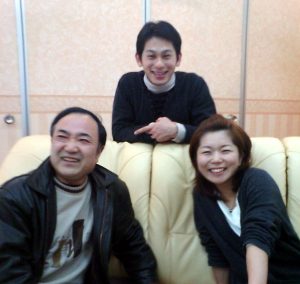
Mr. Ohashi, Nobuo and Yuka
In Kashiwazaki I helped Nobuo teach English to his students from 2PM to 8:30PM. It was nice to see Mr. Ohashi again who I met at least 3 times previously, and I got to meet Yuka for the first time. That evening I stayed at Nobuo’s parents house.
The next morning after eating a great breakfast, Nobuo’s mother took me to the Kashiwazaki expressway entrance. I still didn’t know where I would wind up this evening but my general direction was south. The next day I had an appointment to visit friends in Ogaki City in Gifu Prefecture and I had 3 options where to go before that.
Only a few minutes after the first driver picked me up, Nobuo called my cell phone telling me I left my reading glasses! I just had to go back and pick them up. Nobuo’s mother kindly went back to the expressway entrance and I got a quick ride back and met her.
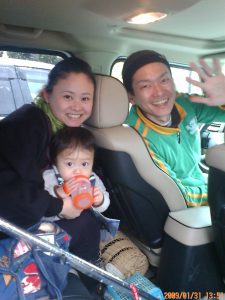
Chieko, husband Jun and baby Shishi
January 31, 2009: Today my destination is Ogaki City in Gifu to see Philip and Maria. I took a bus to the Suita Service area on the Meishi Expressway. The first car was a young couple with a one year old boy. They took me as far as Kyoto. The second driver, a software engineer, took me all the way to Ogaki city — a good 150 kilometers from Kyoto. But he could take me only as far as the expressway bus stop exit. I still had 10 more kilometers to go, a bit too far to walk and the city is not familiar. But I learned I learned I don’t really need to learn the roads because the local people know them well. After a quick lunch, I just went to the road and started hitch-hiking again. A young man picked me up and took me right to my destination. 🙂 He says he makes good money maintaining Bullet train tracks.
Feb. 1, 2009: I went to Nagoya and met my good friend Silvio from Brazil and his Japanese friend Junko. We had a good chat about their projects.
February 2-3, 2009: I visited my Brazilian friend Paulo and his school, ‘Escola Sao Paulo’ in Anjo City, Aichi Prefecture. He had lots of work for me making sure all the school computers were free of web-bugs, trojans and viruses. I looked at 7 PCs in all, all Notebook computers, and installed Avast Anti-virus on most of them.
Being in the Brazilian school is almost like being in Brazil itself. I had fun picking up Portuguese words and talking to the dear Brazilian people. Most of them cannot speak English, but they all do know some Japanese. Many of them are very good Japanese speakers.
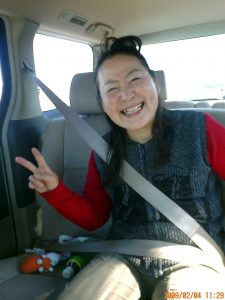
Mrs. Iida
February 4, 2009: Because my business in the Osaka area was not finished, I hitch-hiked from Kamigo Service area near Anjo City back to Osaka in 4 cars. The third car was Mr. and Mrs. Iida and their dog, Rimi. I love dogs and Rimi let me pet her, but she still didn’t seem to trust me completely throughout the trip. The Iida family took me as far as Yoro Service Area on the Meishin Expressway. From there a man who works as postal carrier took me the rest of the way to Osaka. He happened to be going to the very area I needed to go, and took me right to my friend’s house!
February 5, 2009: I went to Kyoto to help my friend Joseph teach English at his school. Spent all day with him from 10AM till 8:30PM.







